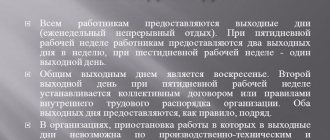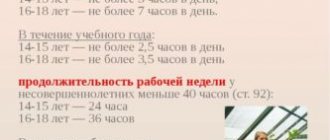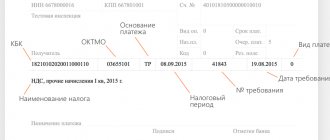pereryv_v_rabote_po_trudovomu_kodeksu.jpg
Related publications
Breaks during the working day are necessary to restore the physical strength of employees, no matter what positions they work in. The law does not allow employers to deprive subordinates of the right to short-term rest during a shift or working day, and sets minimum and maximum limits for certain breaks. Taking into account the requirements of the Labor Code of the Russian Federation (abbreviated as Labor Code), company managers can independently determine the exact time and place of rest, the need for additional “breaks” in work and other conditions.
Order establishing regulated breaks
Important to know! Payment for breaks that are allocated to feed children is carried out according to the average salary, therefore all accruals must be reflected in documents for recording working hours in a separate column. If an enterprise uses unified forms, then it is necessary to additionally implement a code for such breaks, since it is not provided.
The woman must indicate in her application how she wants to manage her breastfeeding time. It can be added to the lunch break, increasing the total duration of rest. Another option is to add up all the breaks at work that are due during the day and move them to the morning or evening in order to shorten the working day.
Breaks during working hours: varieties
During the working day, an employee has the right to take advantage of various breaks at work:
for food and rest (breaks, traditionally called “lunch”) - Art. 108. TK;
for heating and rest (under certain working conditions, as well as for workers engaged in unloading and loading activities) - Art. 109. TK;
technological breaks (due to the specifics of production) - Art. 109. TK;
for feeding infants (up to 1.5 years) - 258th Art. TK.
All of the above work breaks have features that employers and employees should be aware of.
Lunch break
The break for meals and rest has clear boundaries - no less than 30 minutes during the working day, but no more than 120 minutes (2 hours). An employer has the right not to provide employees with a lunch break only if they work for him no more than four hours a day. But this condition must be recorded in the company’s internal regulations or in the employment contract.
Even if an employee works a 12-hour workday, lunch breaks during one shift cannot exceed two hours. They can be divided into several rest periods, but in total they must fit within these limits.
As a general rule, lunch time is not paid by the employer, with the exception of certain situations. The various legal nuances of the lunch break are discussed in our separate article.
Special work break for warming up
Unlike lunch, warming breaks are payable because they are included in working hours. This type of rest is provided if the employee performs work:
related to loading and unloading activities;
outdoors (during the cold season);
in an unheated room.
Article 109 of the Labor Code notes that a warm-up break may also be provided to other employees if the employer deems it necessary. The duration of heating breaks depends on weather conditions (air temperature, wind speed) and is set by the employer.
Technological interruptions in work
These breaks, their time, duration and order of provision are regulated by the Internal Regulations. The employer decides what kind of break is necessary in order to:
to preserve the health of subordinates as much as possible (for example, a regime of “non-working” ventilation, cleaning of premises, etc. is established);
support the normal production process (in particular, in medical institutions a short break is necessary to sterilize instruments);
minimize the negative impact of existing equipment.
Breaks for feeding children
This break from work, according to the Labor Code, is provided to workers who have children no older than one and a half years (in addition to lunch rest). If there is only one child, the feeding break lasts at least half an hour and is given to the woman every 3 hours. If there are two or more children under the age of 1.5 years, the duration of the break should be at least an hour.
The employer includes a break for feeding babies in working hours and pays in the amount of the employee’s average earnings.
Types of breaks at work
Almost everyone knows that when working for eight hours you have the right to lunch. Often the schedule is drawn up taking into account this period, for example, lasting thirty and sixty minutes. Along with this break, the legislation provides for others. Conventionally, they are divided into several groups:
- general and special;
- mandatory and recommended;
- paid and not.
The first category implies that general free time is provided to absolutely all citizens, regardless of their place of service and personal needs. But special ones are given either to special employees (breastfeeding women) or to specific types of employees (for example, those who constantly work at a computer).
As for mandatory breaks, these periods of time are necessary for everyone, but the principle of providing recommended ones is determined by the company’s internal documents. For example, if an employer considers it necessary to organize rest during the day for walks in the park, he includes this in the collective agreement.
According to the Labor Code, a smoke break does not fall into any of these categories, but employees also have a legal right to it, unless it is prohibited by the internal regulations of the enterprise.
Find out whether all employees are required to take lunch and how long it can last, how many times during a shift they should take time away from the computer, and what to do if an employee requires time off from work to feed a small child.
No matter how busy the production process may be, the law allows, and in some cases even requires, breaks from work. General ones are provided to everyone without exception, special ones are provided only to employees holding certain positions, having family responsibilities or performing special types of work.
Lunch is provided once during a working day or shift in the manner prescribed by Article 108 of the Labor Code of the Russian Federation. Every employee has the right to a nutritious hot meal. The exception is cases when, for objective technical reasons, such a break is impossible, but this does not mean that the employee must work all day without lunch. The employer is obliged to create all conditions for heating and eating food directly at the workplace.
If the total duration of the shift does not exceed four hours, for example, in conditions of reduced working hours, a meal break may not be provided. But the condition of no lunch should be reflected in the employment contract, work schedule or local act, since this is not something taken for granted.
A break for heating and rest is provided only when performing certain types of work (Article 109 of the Labor Code of the Russian Federation). As a rule, we are talking about loading and unloading and other work performed in the cold season in the open air or in unheated rooms (warehouses, hangars, etc.).
The list of specific types of activities that provide for such breaks during the working day and the conditions for their provision are fixed in the internal labor regulations.
A break to feed a child is provided to working women with children under the age of one and a half years, on the basis of Article 258 of the Labor Code of the Russian Federation. This is one of the guarantees provided to persons with family responsibilities, therefore, if necessary, fathers raising children without a mother, guardians or trustees of children can take such breaks during the working day (shift) (Article 264 of the Labor Code of the Russian Federation).
We invite you to familiarize yourself with the period during which maternity benefits must be paid
It does not matter what type of feeding the child is on - breast or artificial. In both the first and second cases, the right to breaks in work under the Labor Code is retained. To put it into practice, issue an order in free form based on a written statement from the employee. A copy of the child's birth certificate confirming his age is attached to the application.
Technological. This is the name for regulated breaks when working on a computer and using other technical means. In some cases, technological breaks when working at a computer and other devices that require constant focus and concentration are necessary to relieve the stress on the nervous system and visual organs.
In others, they are designed to ensure the correct operation of production equipment that cannot function continuously.
The procedure in which staff are provided with breaks when working at a computer or machine, driving a car or other types of equipment is prescribed in a collective or labor agreement, internal labor regulations, and agreements.
As it was before
Until February 1, 2002, in Russia it was not the Labor Code, but the Labor Code - the Labor Code, in accordance with which legal relations between employees and employers were regulated, their rights and obligations were established.
According to the Labor Code, breaks from work for rest and meals had only a maximum duration of 2 hours (Article 57). Their lower, that is, minimum limit was not determined by the legal act. In the 57th Art. The Labor Code also noted that a lunch break, as a rule, should be provided to employees 4 hours after the start of their working day. In addition, the old code did not give employers the right to deprive employees of “lunch” if they work no more than 4 hours a day. Such an opportunity appeared recently in the current Labor Code - in June 2020 (Law No. 125-FZ of June 18, 2017).
The Labor Code did not provide for breaks during working hours for heating and rest, but noted that special working conditions may be established for workers involved in certain sectors of the national economy (Article 252 of the Labor Code).
Establishing the types and duration of breaks
The duration of weekly uninterrupted rest cannot be less than 42 hours.
The structure of the working day must be approved in the developed documentation. All employees must be familiar with the approved procedures, because Failure to comply with legislation, work schedules and work hours entails negative consequences on the part of both the employee and the employer.
To summarize the above, we can say with confidence that maintaining a balance between work and rest will have a positive impact on both the physical and psychological state of employees and on labor productivity. It has been proven by many years of experience that those employees who have the opportunity to take several short breaks during their working hours are less tired and bring more benefit to the company.
But at the same time, workers should not abuse the trust and goodwill of their superiors, which allows them to take such breaks, and does not force them to work tirelessly from eight in the morning to seven in the evening. There must be moderation in everything. And if it is not observed, then the labor legislation of the Russian Federation comes into play, which provides for penalties for violation of labor discipline. Ignorance of the law does not exempt you from responsibility.
https://youtu.be/g5jXtXbIXIk
Technology break concept
Article 107 of the Labor Code of the Russian Federation states that the form of rest time is breaks during the working day. Article 109 of the Labor Code of the Russian Federation states that certain areas of work require mandatory rest breaks. The need for these breaks is determined by the specifics of technology, operating and production conditions. The list of work requiring a break is recorded in the rules of local disorder.
There are these types of breaks:
- A technological break, which is needed to ventilate the room. It is necessary to reduce the concentration of harmful elements in the air.
- A break for cleaning the premises. Needed to eliminate contamination from waste generated during production or processing.
- The time periods required to update the online information base. This is relevant if the database is replenished from external sources.
Types of technological breaks
Technological breaks are divided into types depending on what needs they are caused by.
Working at the computer
- Activities with a load level per shift of up to 20,000 characters. Time: 2 hours from the start of the shift and 2 hours after the lunch break. The duration of stops is 15 minutes.
- Load up to 40,000 characters – 2 hours after the start of the working day and 1.5-2 hours after the lunch break. There are 2 stops of 15 minutes or breaks of 10 minutes every hour of activity.
- Load up to 60,000 characters – 1.5-2 hours from the start of the working day and 1.5-2 hours after the lunch break. The duration of stops is 20 minutes. An alternative option is 15-minute stops every hour of operation.
The purpose of the break is to preserve the employee’s health. Rest helps prevent eye strain and fatigue.
12 hour workday
- 2 lunch breaks.
- 4 additional breaks of 10 minutes each.
- Break for a short nap lasting 45-60 minutes.
The last break is given after the first lunch break. It should be noted that this list of rest periods is a recommendation. That is, the employer has the right not to implement this entire list. The Order of the Ministry of Health and Social Development of the Russian Federation No. 181n dated March 1, 2012 does not contain the list in question.
The agreed list of breaks is needed to prevent employee stress, tension and overwork. Short-term periods allow the employee to recover, which leads to increased work efficiency. In addition, they are needed to improve working conditions for workers and ensure their health.
Working in low temperature conditions
Breaks are provided to employees who work under these conditions:
- Cold season and outdoor work.
- Work in closed, unheated spaces.
In this case, rest time is needed for heating. Lack of a break can lead to frostbite and decreased quality of work.
Hard work
Breaks are provided to loaders engaged in loading and unloading operations. This is due to the fact that these employees work with heavy weight. Continuous work can lead to fatigue and injury.
How to regulate breaks at work?
Employees need breaks from work not only because of possible hypothermia, but also because of physical fatigue from performing heavy physical labor. It is necessary to ensure that employees eat hot food during lunch. After a hot lunch, you should not go out into the cold air for ten minutes. The methodological recommendations contain the value of the maximum permissible level of employee cooling.
Attention
It is this document that the boss should study in order to set the standards for breaks and their number for workers who work outdoors or in a cold room. In order to determine the permissible duration of an employee’s one-time stay on the street during the cold season, you need to refer to the table from the manual.
The activity the employee is engaged in and temperature indicators are also taken into account. At the same time, from the provisions of individual regulations, we can conclude that the need for a break for rest and food, according to the general logic and rules of sanitary standards, arises after the employee has worked for four hours, see, for example, paragraph 9 of the resolution of the USSR State Committee for Labor, the Secretariat All-Union Central Council of Trade Unions dated April 29, 1980 No. 111/8-51, clause 7.6.2 SP 2.5.1198-0, approved by the resolution of the Chief State Sanitary Doctor of Russia dated March 4, 2003 No. 12, clause 9.8 SanPiN 2.2.3.1385-03, approved by Decree of the Chief State Sanitary Doctor of Russia dated June 11, 2003 No. 142. Important
In order to normalize the heat exchange of the worker, the air temperature in the heating areas is maintained in the range of plus 21-25. 4. When organizing work in open areas and in cold (unheated) rooms, additionally provide for the following requirements: 4.1.
When the outside air temperature is below minus 30, work involving heavy manual physical labor and high-risk work is permitted only with the development of additional measures to ensure the protection of workers from local and general hypothermia.
Grounds for granting a break
Breaks are established on the basis of a bilateral agreement between the staff and the employer. The basis for providing time for rest is regulations, the Labor Code of the Russian Federation. However, articles 107 and 109 of the Labor Code of the Russian Federation do not spell out the details. The latter are determined by local acts. For example, these are internal rules. They include this information:
- Working and rest conditions for employees.
- List of types of activities and categories of workers that require technological breaks.
- Number of stops and their duration.
FOR YOUR INFORMATION! It is necessary to distinguish between breaks that are needed for heating and rest, and breaks intended for nutrition. The latter are regulated by 108 Labor Code of the Russian Federation.
Duration
The duration of technological breaks, according to the “Letter of Rostrud dated April 11, 2012,” is initially included in the number of working hours during the day and is not added to the main schedule. The employer determines how long the break lasts.
The break should not be too short or long. The exact duration of the technological break is established in accordance with working conditions and work characteristics. It is regulated in accordance with Articles 108 and 109 of the Labor Code of the Russian Federation. The rest time is determined only by the employer.
also possible to set a break every hour , if the work requires it, this is already being considered by the employer.
When applying for any job, you need to read the employment contract and find out information about breaks. After all, if there are not enough breaks or they are not long enough, a person may become overtired. A healthy and regulated break is the key to productive work .
Watch a video about taking breaks during the workday:
Duration of stops and their payment
The duration and frequency of stops are established based on an agreement between the employer and the team. The agreements reached can be included in an individual employment contract with a specific employee.
Stops are included in working hours and are paid for. Typically, employees do not leave their work area during a break.
FOR YOUR INFORMATION! The number of stops and their features are determined by the employer. However, there is an important condition - they should not worsen the situation of the worker or violate his rights.
Responsibility for failure to take breaks
Refusal to provide a break is a gross violation. Most employers try to follow the letter of the law. But what to do if an employee is faced with an offense in this area? It makes sense to send an application to the labor inspectorate. It is advisable to send a petition from the entire team, since in this case the possibility of a favorable outcome of the case increases.
The main problem for an employee in such a situation is providing evidence of an offense. A collective statement allows you to automatically make a complaint more significant and support it with evidence.
The labor inspectorate reviews the application and then checks the employer's company. If an offense was discovered by representatives of the inspectorate, the manager is fined on the basis of 5.27 of the Code of Administrative Offenses of the Russian Federation. A trial is possible, during which the employer is obliged to pay compensation to employees in the amount of double salary.
Breaks while working at the computer
The specificity of working at a computer is that the employee spends a long time in one position - sitting at the monitor. This factor, along with others (radiation, stress, eye fatigue), has an adverse effect on the employee’s health. Therefore, the employee must take breaks when working at the computer. The Labor Code of the Russian Federation does not directly regulate this problem, but employers may be interested in the question: is there an obligation for them to provide employees with such breaks. Answer: yes, installed.
Rest time when working at the computer
Based on Article 107 of the Labor Code of the Russian Federation, breaks during the working day are recognized as one of the types of rest time.
According to Article 109 of the Labor Code of the Russian Federation, some types of work imply the need to provide workers with the opportunity to rest during the working day, which is caused by the specifics of technology, production and working conditions. A specific list of such work and the procedure for providing appropriate breaks must be provided for by internal regulations.
Article 27 of the Law on Sanitary and Epidemiological Welfare of March 30, 1999 states that working with machines and various devices should not have a harmful effect on health.
For violation of current sanitary rules, Article 6.3 of the Code of Administrative Offenses of the Russian Federation provides for administrative liability.
Features of providing a break for rest and food during the working day
Is there a regulation regulating the time for providing a break for rest and food during the working day, and indicating that this break is provided only after the actual time worked in the amount of four hours?
The procedure for providing breaks for rest and food is regulated by Art. 108 Labor Code of the Russian Federation.
Extract from the Labor Code of the Russian Federation
Article 108. Breaks for rest and food
During the working day (shift), the employee must be given a break for rest and food lasting no more than two hours and no less than 30 minutes, which is not included in working hours.
The time for granting a break and its specific duration are established by internal labor regulations or by agreement between the employee and the employer.
At jobs where, due to production (work) conditions, it is impossible to provide a break for rest and food, the employer is obliged to provide the employee with the opportunity to rest and eat food during working hours. The list of such work, as well as places for rest and eating, are established by the internal labor regulations.
According to Part 2 of Art. 108 of the Labor Code of the Russian Federation, internal labor regulations or by agreement between the employee and the employer must establish both the time of the break and its specific duration. The legislator limited only the maximum and minimum duration of breaks for rest and food.
As you can see, in the Labor Code of the Russian Federation there are no restrictions on the time of providing breaks for rest and food during the working day, or indications of the need to work four hours before the break is provided.
Some regulatory documents contain recommendations for providing a rest and meal break in the middle of the working day to certain categories of workers. For example, clause 24 of the Regulations on the Peculiarities of Working Time and Rest Time for Car Drivers[1] establishes that drivers are given a break for rest and food lasting no more than two hours, usually in the middle of a work shift. The document further states that if the daily work (shift) duration established by the shift schedule is more than 8 hours, the driver may be provided with two breaks for rest and food with a total duration of no more than 2 hours and no less than 30 minutes. It is noted that the time for providing a break for rest and food and its specific duration (total duration of breaks) are established by the employer, taking into account the opinion of the representative body of employees or by agreement between the employee and the employer.
According to sub. 2.1 Recommendations for the application of flexible working time regimes in enterprises, institutions and organizations of sectors of the national economy [2] (hereinafter referred to as the Recommendations), one of the components of flexible working time regimes and schedules is a break for meals and rest, which usually divides fixed time into two approximately equal parts (a similar norm is given in clause 3.3 of the Regulations on the procedure and conditions for applying a sliding (flexible) work schedule for women with children [3]).
Note!
From the above norm we can conclude that flexible working time schedules must establish the time and duration of breaks for rest and meals.
In some cases, it is simply impossible to set a strict rule about the need to work 4 hours before the first break. For example, in accordance with clause 9 of the Regulations on the procedure and conditions for the employment of women with children and working part-time [4], a break for rest and food is provided to women working part-time if the length of the working day (shift) exceeds 4 hours. Thus, if the working time is, for example, 6 hours, then a break for rest and food can be set either 4 or 3 (or another time period) hours after the start of work.
Some workers are asking for their rest and meal breaks to be moved to the end of the working day, which would allow them to go home earlier. However, moving the break to the end of the working day effectively results in the employee remaining without a break during working hours , as required by law. Inspection bodies may assess such terms of the employment contract as worsening the employee’s position compared to the conditions guaranteed to him by labor legislation, and fine the employer under Part 1 of Art. 527 Code of Administrative Offenses of the Russian Federation.
By the way
The article by N. A. Matsepuro “Is it possible to postpone lunch to the end of the day” (General Book, No. 4, February 10, 2012) provides the opinion of the deputy head of Rostrud, I. I. Shklovets: “Breaks for rest and meals provided for in Art. 108 of the Labor Code of the Russian Federation, must be provided during the working day. Providing such breaks at the end of the working day would defeat the purpose of such breaks.”
Thus, the time for providing certain categories of workers with breaks for rest and food during the working day, as well as their duration, are established in compliance with the requirements of Art. 108 of the Labor Code of the Russian Federation in the internal labor regulations, employment contracts or additional agreements to them.
[1] Approved by Order of the Ministry of Transport of Russia dated August 20, 2004 No. 15.
[2] Approved by Resolution of the USSR State Committee for Labor No. 162, All-Union Central Council of Trade Unions No. 12-55 of 05/30/1985. In accordance with Art. 423 of the Labor Code of the Russian Federation are applied to the extent that does not contradict the Labor Code of the Russian Federation.
[3] approved by Resolution of the State Committee for Labor of the USSR, All-Union Central Council of Trade Unions dated 06.06.1984 No. 170/10-101.
[4] Approved by Resolution of the State Committee for Labor of the USSR and the Secretariat of the All-Union Central Council of Trade Unions dated April 29, 1980 No. 111/8-51.
Time of regulated breaks when working on a computer
By virtue of Article 22 of the Labor Code of the Russian Federation, the employer must ensure safety and compliance of working conditions with all necessary requirements (including when working at a computer).
According to the Instructions, the duration of working with a computer without a break can be no more than two hours.
The purpose of breaks is to reduce tension, eye fatigue, etc.
The instructions establish the dependence of break times on the type and time of work performed by dividing into groups:
- A – reading information from the monitor upon request;
- B – typing on the keyboard to enter information;
- B - creative work.
In addition, a division into categories of complexity of work is provided:
- for group A (not more than 60,000 characters read per shift), the break is 15 minutes, provided twice - two hours after the start of work and the lunch break;
- for group B (no more than 40,000 printed characters per shift) the break is 10 minutes after every working hour;
- for group B (no more than six 6 hours per shift), the break is 15 minutes after every working hour.
If a shift lasts twelve hours, the time for regulated breaks when working on a computer for eight hours of work is provided in the above order, and for the remaining four hours - fifteen minutes for each hour (regardless of the category).
Order on the introduction of regulated breaks
Such a break is classified as a technological one, and its main purpose is not so much to rest the employee, but to comply with the rules of working with technical equipment and production facilities. This kind of downtime can be regulated by concluding a collective agreement or established labor regulations. For employees who constantly deal With monitors and video displays, there are certain standards for breaks. ORDER of the Ministry of Communications of the Russian Federation dated 07/02/2001 162 ON THE APPROVAL AND ENTRY INTO EFFECT OF STANDARD INSTRUCTIONS FOR OCCUPATIONAL SAFETY (2018) Relevant in 2020 1.
https://youtu.be/QX1qdSUWNl8
Attention Types of work activities are divided into 3 groups: group A - work on reading information from a computer screen with a preliminary request; group B - work on entering information; Group B - creative work in dialogue mode with the computer.
What is a technological break under the Labor Code?
Regardless of their job, most people have the right to a legal break or lunch . In this case, the break can be standard (applicable to all personnel) and technological. This article is devoted to the essence of the technological break and its government regulation.
Dear readers! Our articles talk about typical ways to resolve legal issues, but each case is unique.
If you want to find out how to solve your particular problem, contact the online consultant on the right or call the free consultation numbers:
What is a technological break?
Any employee should have the opportunity to rest a little, which is provided to all employed citizens by law. A technical break is introduced by the employer , since the type and duration of rest directly depend on production technology and working conditions.
A technological break is a time during which it is impossible to perform work due to the nature of the technological process.
Regulation of issues related to technological interruption is carried out in accordance with the articles of the Labor Code of the Russian Federation affecting this topic. Thus, the rest time should not be lower than the norms prescribed in the Labor Code of the Russian Federation , otherwise the employer may incur legal liability.
In Russia there are three main types of technological recreation , enshrined in Article 109 of the Labor Code of the Russian Federation:
- Break to ventilate the room. All personnel are removed from the premises for a certain time to eliminate accumulated chemicals and harmful elements.
- Break to update information. If the work involves receiving and processing data online, a technological break is necessary, during which the information is updated to the required indicators.
- Break for cleaning the premises. During a break, the room is cleared of waste accumulated during work, the spread of which in the future can negatively affect the productivity of workers.
In this article you can read about the lunch break.
Peculiarities
The nature of technological breaks is determined to a large extent by working conditions . This or that feature of rest also depends on them:
- Regulated breaks in production. Factories, enterprises and factories set their own conditions for technical rest, which are associated with labor intensity and the risk of injury.
- A break while working on a personal computer. At work closely related to computer work, the Labor Code of the Russian Federation regulates technological breaks. They are regulated according to SanPin 2.2.2/2.4.1340-03. The size of the break varies from 50 to 140 minutes per day (established by Appendix 7 to SanPin), the exact duration depends on the position held by the employee and the degree of workload. Without a break, an employee can work at a PC for no more than two hours.
- Break between shifts . In the case of a shift work schedule, the Labor Code sets restrictions. The technological break between shifts cannot be less than 12 hours, and the more shifts there are in a row, the longer the rest should be.
- Smoke breaks . As such, there is no state regulation of smoking breaks, but, according to the Labor Code, an employee can do whatever he wants during his lunch break if it does not cause damage to the enterprise. In fact, this means that you can smoke during your lunch break, but in a specially designated area. Also, many employers introduce a special smoking schedule at the enterprise.
- Warm up break . Technological breaks are also provided to employees whose working conditions do not meet temperature standards, that is, it is constantly cold indoors/outside. There is no set time for heating. Failure to take such breaks can lead to frostbite or contracting a virus.
- Shift break 12 hours. If an employee works twelve hours in a row, according to MP 2.2.9.2311-07, he is provided with additional benefits. It is recommended to have at least two lunch breaks per day. Throughout the working day, the employee is given four short breaks (10 minutes). An employee can even sleep a little after the first lunch break, but no more than 1 hour.
- Break during construction. Since construction is a fairly dangerous and tiring profession, technical breaks are provided for workers. When working for a long time without rest, a person’s work efficiency decreases, which can lead to overwork at best, and at worst - to an accident.
to contents








